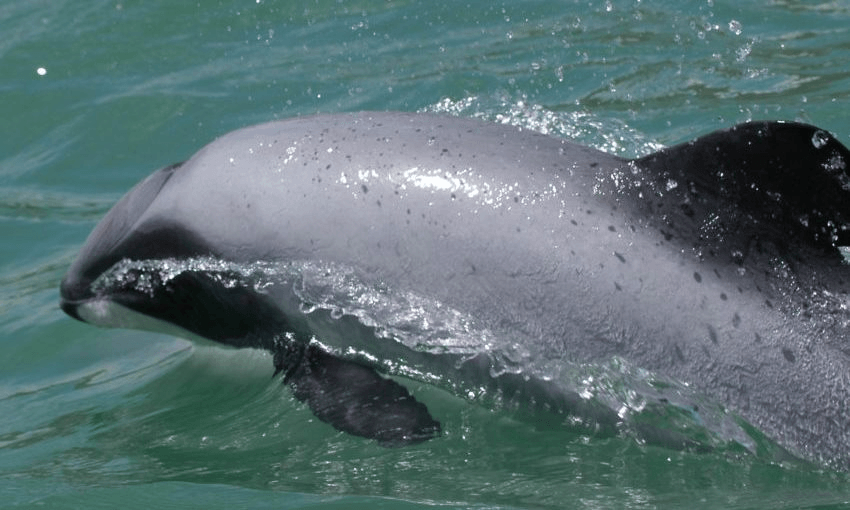The New Zealand wing of the world’s largest conservation organisation has crossed enemy lines to team up with two large fishing companies on a proposal to mitigate the threat to a critically endangered species… and other environment groups aren’t buying it.
Wildlife conservation group WWF-New Zealand has partnered with two major fishing companies on a Māui dolphin protection proposal that puts it at odds with other environment groups.
The Māui’s dolphin is the world’s smallest and rarest dolphin – there are estimated to be between 57 and 75 remaining. In June this year, the government opened consultation on a plan proposing four options to protect the Māui dolphin and the vulnerable Hector’s dolphin from fishing-related threats. Conservation groups widely criticised all the options but the day after submissions closed, WWF-New Zealand announced it had partnered with Sanford Ltd and Moana New Zealand on a new proposal it called “Option 5”.
The proposal, which WWF-New Zealand says will “protect Māui dolphins while taking care of those affected by changing the approach to fishing”, focuses on data gathering, information sharing, risk management and education, rather than calling for a ban on set nets and trawling in Māui dolphin habitats, which WWF-NZ has done in the past. Both Greenpeace and Forest & Bird advocate such a ban.
In a piece published on The Spinoff in May this year, WWF-New Zealand chief executive Livia Esterhazy wrote: “We’re calling on this government to do what is necessary to protect the remaining Māui dolphins and allow them to thrive. This must include banning all set nets and conventional trawling within their habitats”.
For close to two years, the WWF-New Zealand website has also hosted a pre-populated online submission form for supporters to petition the government to end set-netting and trawling in the Māui dolphin habitats.
On Friday Esterhazy told The Spinoff that WWF-New Zealand stood by its earlier position, but the organisation was trying “a new approach”. She said more than 10,000 people had submitted the online form, which was going directly to the government, but the organisation had realised a “middle ground” was needed so the government wasn’t stuck with “two extremes” – the fishing industry opposed to regulation at one end and conservation groups calling for a ban at the other.
“When the consultation document came out it was clear to us there was going to be two factions and the government was going to have to try to negotiate, and you’d have both ends of the spectrum fighting with each other,” Esterhazy said.
“What we’re trying to do is negotiate with the fishing industry and come up with a plan so the government’s not stuck with the two extremes.
“This is the fifth time the threat management plan has gone round for consultation and [Māui dolphins] are still hugely threatened. We just want to see action and that’s why we’re trying, on top of everything else, this new approach.”
Following the announcement of Option 5, Forest & Bird and Greenpeace urged the government to reject WWF-New Zealand’s proposal, with both organisations putting out press releases saying the plan was based on complicated and unproven methods.
Greenpeace labelled the WWF-NZ proposal the “Sanford plan” and said it was a danger to Māui and Hector’s dolphins, while in the Forest & Bird statement, chief executive Kevin Hague said: “New Zealanders don’t want to gamble with the extinction of dolphins. We respect WWF-NZ for attempting to find common ground with some in the fishing industry, but we do not support their proposed option, and we don’t believe other conservationists will either.”
On its website, WWF-New Zealand lists Moana, the country’s largest iwi-owned fishing company, as a key partner. The organisation receives $135,000 from the company annually.
Asked if these financial benefits had anything to do with WWF-NZ’s change in stance regarding Māui dolphins, Esterhazy said that while she could understand why that perception may exist, “I can categorically say that no money has changed hands on this Māui and Hector’s dolphin threat management plan.”
She said Moana paid WWF-NZ to be a “sustainability consultant” to help the company work towards a zero-carbon, low-waste model.
The organisation had never received any funding from Sanford, Esterhazy said.
WWF-New Zealand had worked with Sanford and Moana, the two biggest commercial fishing companies operating in the Māui dolphin habitat area off the west coast of the North Island, on a protection plan that was released in 2016 and on which the new proposal builds.
“They committed to stop set netting and transition to dolphin-safe fishing by 2022, and they have been voluntarily shifting all their gear to either long-lining or other dolphin-safe methods,” said Esterhazy.
“Sanford and Moana do not have to do this – they could have sat on their 2016 Māui dolphin protection plan and said ‘that’s good enough thank you very much’, but we were the ones that called them and said ‘yeah nah, can we try to push this even further, can we do something more?’,” said Esterhazy.
“And they stood up to that, they stepped up to the plate and went OK, let’s see what that would look like. It’s been hard work and no money.”
Submissions on the Māui dolphin protection plan are now being analysed and decision documents are expected to be provided to ministers in October.
